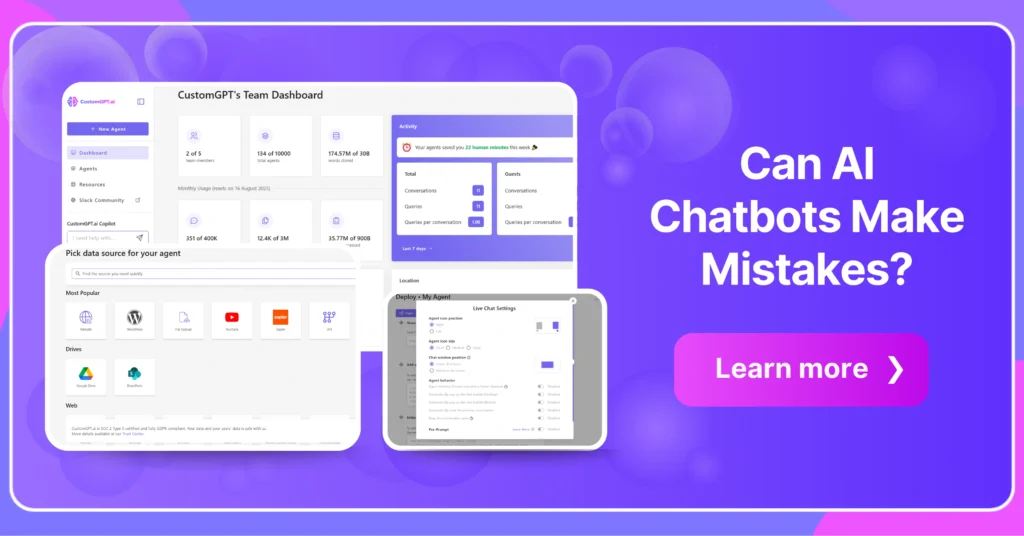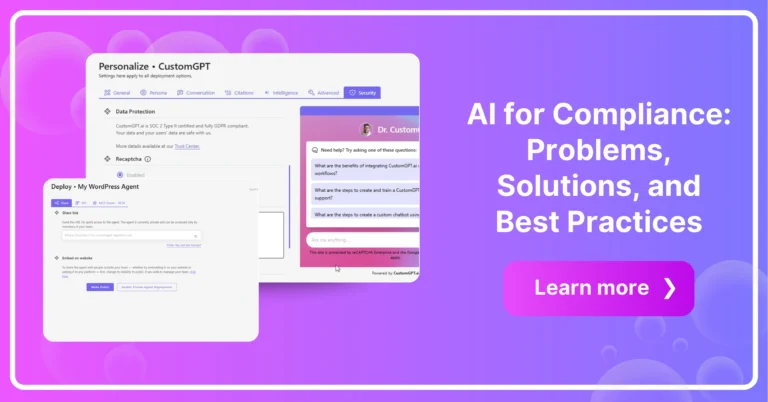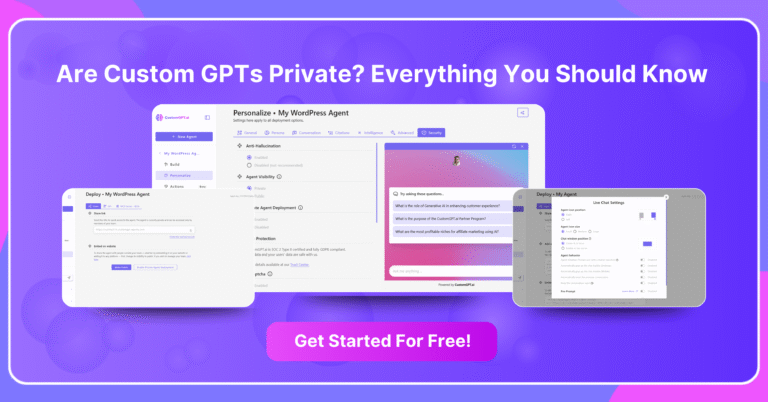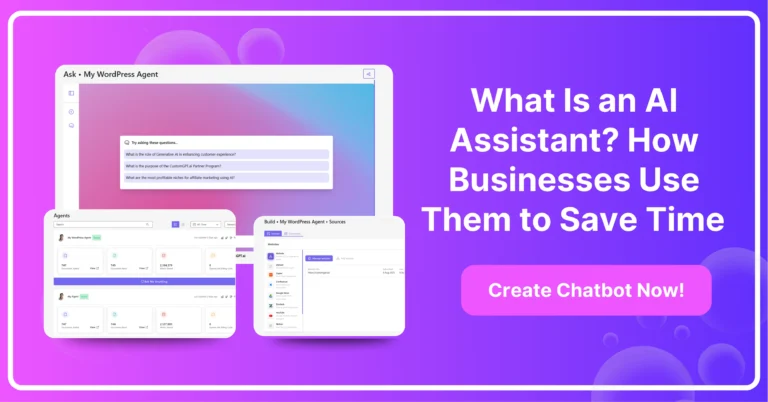Yes, AI chatbots can and do make mistakes, sometimes small, sometimes significant. While they’re impressive tools, they’re not perfect and still require human oversight.
TL;DR
- AI chatbots often make mistakes like misinterpretation and hallucination.
- Errors hurt trust, user experience, and business outcomes.
- Causes include bias, vague inputs, and model limits.
- Small businesses need safeguards like monitoring and fallback flows.
- CustomGPT.ai reduces errors by using only your content for answers.

What Kinds of Mistakes Do AI Chatbots Make?
Even the smartest chatbots can trip up. Here are the most common error types I see:
- Misinterpretation of intent: Sometimes, a chatbot guesses your meaning wrong. You might ask a support question, and it gives you sales info instead.
- Hallucinations & fabricated responses: This is when a chatbot confidently gives a completely made-up answer. It’s not lying, it’s just trying to be helpful without knowing better.
- Outdated or incomplete knowledge: Most AI chatbots aren’t live on the internet. If their training data stops in 2023, they won’t know about 2024 events unless updated manually.
- Context-dropping in multi-turn dialogues: If you have a long conversation, some chatbots forget what you said earlier. That leads to repeated questions or inconsistent answers.
Why Do AI Chatbots Sometimes Make Mistakes?
AI chatbots aren’t perfect because, well, their brains aren’t human. Here’s why things go sideways:
- Data bias: If the chatbot learned from biased, skewed, or incomplete data, its responses will reflect that. It’s not intentional—it’s baked in.
- Model limitations: No model knows everything. Even large ones like GPT-4 can miss nuance or misjudge tone.
- Ambiguous inputs: If your question is vague, the chatbot has to guess. And sometimes, it guesses wrong.
How Do Chatbot Errors Affect User Experience?
Chatbot mistakes aren’t just annoying, they affect how people feel about your brand.
- Frustration: If users have to repeat themselves or get wrong info, they get irritated. You lose engagement fast.
- Reduced trust: A single hallucinated response can make someone question every other answer.
- Business risk: Mistakes in legal, medical, or financial info could create compliance problems or even lead to lost revenue.
Should Small Businesses Worry About Chatbot Risks?
Yes, but it’s less about fear and more about smart planning. Small businesses often lack the buffer to absorb damage from bad customer interactions or misinformation, so precision matters.
- Reputation stakes are higher: A single negative chatbot experience can lead to bad reviews or lost trust, especially when you’re building your name.
- Limited second chances: Unlike big brands, small businesses may not get a “redo” if a chatbot confuses or frustrates a lead on their first visit.
- AI is a customer-facing ambassador: Think of your chatbot as your digital front desk. If it fumbles, it reflects on you—so it deserves attention, even if it’s automated.
AI Chatbots for Small Businesses: Balancing Benefits and Risks
If you run a small business, AI chatbots can be powerful—but they need careful handling.
- Use cases: Think 24/7 customer service, handling FAQs, or even writing social media posts.
- Resource constraints: You may not have a team to constantly monitor the chatbot. That makes choosing the right tool even more important.
- Error mitigation tips: Use a chatbot with built-in monitoring. Set guardrails, create fallback messages, and make it easy for users to reach a human.
What Are the Best AI Chatbots for Business?
There’s no one-size-fits-all, but here are a few that I think are strong contenders for minimizing errors:
1. CustomGPT.ai
- Best for: Companies wanting full control over chatbot knowledge and behavior.
- Why it’s great: You can upload your documents, web pages, or PDFs to create a chatbot that only answers from your content, dramatically reducing hallucinations.
- Error control: CustomGPT.ai has built-in anti-hallucination which prevents off-topic responses with a strict “no training data = no answer” setting.
2. ChatGPT (OpenAI)
- Best for: Versatile business use (support, content, training, internal tools).
- Why it’s great: Offers advanced reasoning, conversation memory, and custom instructions. With the ChatGPT Team or Enterprise plans, you can securely integrate your own knowledge base and monitor usage.
- Error control: Includes moderation tools, conversation context handling, and retraining via custom GPTs.
3. Claude (Anthropic)
- Best for: Safe, compliant, and ethical chatbot use.
- Why it’s great: Trained with Constitutional AI for low-risk outputs. Strong performance on long documents and sensitive use cases (like HR or legal FAQs).
- Error control: Safer out-of-the-box defaults; Claude 3 shows improved resistance to hallucination.
4. Google Gemini (formerly Bard)
- Best for: Businesses embedded in the Google ecosystem (Drive, Gmail, Docs).
- Why it’s great: Pulls live data from Google Search. Works well for customer-facing queries and productivity integrations.
- Error control: Live search helps avoid outdated answers, but still needs oversight for accuracy.
5. Microsoft Copilot
- Best for: Teams using Microsoft 365 (Outlook, Excel, Teams).
- Why it’s great: Embedded directly into Office tools, enhancing productivity without context switching.
- Error control: Uses enterprise-grade AI models and integrates permissions/security settings from Microsoft.
Each of these tools offers a different mix of flexibility, safety, and customization. The best one for your business depends on your goals, how much control you want over responses, and whether you prioritize automation, safety, or integration with existing systems.
How Can You Reduce Chatbot Mistakes?
Even the best chatbot benefits from some smart guardrails. Here’s what I recommend:
- Thorough training: Feed the bot clean, well-structured, up-to-date information specific to your business.
- Continuous monitoring: Check its performance regularly. Catch issues before users do.
- Fallback flows: If the bot gets confused, have it politely redirect the user to a human or a support form.
- Human-in-the-loop: Let your team oversee and correct the bot’s output when needed, especially for high-stakes answers.
What Tools Help You Monitor and Debug Chatbots?
Don’t fly blind. These tools help you track chatbot performance and debug issues fast:
- Analytics dashboards: Most platforms show key metrics like response accuracy, bounce rates, and top missed questions.
- Log tracing: Lets you follow the bot’s decision-making process. Super helpful for understanding why it made a bad call.
- Automated alerts: Set rules to notify you if the bot gives a certain type of response or uses flagged keywords.
How Does CustomGPT.ai Prevent Chatbot Mistakes?
CustomGPT.ai is built to eliminate guesswork and hallucinations by restricting answers to your own uploaded content.
- Source-grounded responses: The chatbot won’t invent answers—it only replies using the documents you provide. No data = no response.
- Anti-hallucination architecture: It’s specifically designed to avoid generating “best guess” responses common in general-purpose models.
- Custom control: You decide what content is included, so answers stay accurate, consistent, and brand-safe.
- Real-time updates: Want to fix an error? Just update the source file—no retraining or coding needed.
CustomGPT.ai makes it easy to build a chatbot you can actually trust—with zero fluff, zero fabrications.
Quick FAQs
Can I trust AI chatbots with sensitive data?
Only if the platform prioritizes security and lets you control what the bot sees. Tools like CustomGPT.ai support private, isolated deployments and document-level access.
How do I diagnose chatbot errors?
Review logs, user feedback, and look for patterns in misunderstood queries.
Are smaller chatbots less accurate than enterprise ones?
Not always. Smaller models trained on high-quality, relevant data can outperform generic enterprise bots.
What’s the best way to log and analyze chatbot mistakes?
Use integrated dashboards and export logs for manual review or machine learning analysis.
Can AI chatbots learn from their errors automatically?
Some platforms support feedback loops, but usually they need human input to “learn” correctly.
Conclusion:
Yes, AI chatbots make mistakes, but smart choices and proper setup can reduce them. CustomGPT.ai gives you full control, using only your content to generate accurate, on-brand answers.
Our secure, centralized AI knowledge platform is designed to handle helpdesk deflection, content generation, team training, and knowledge management, all while keeping chatbot errors in check.
With its anti-hallucination feature, it answers only from your uploaded content, ensuring accuracy and control.
Let’s make your AI work for you, not against you. Ready to deploy a chatbot you can actually trust? Get started with CustomGPT.ai and build your own AI—powered by your knowledge.
Build a Custom GPT for your business, in minutes.
Drive revenue, save time, and delight customers with powerful, custom AI agents.
Trusted by thousands of organizations worldwide








